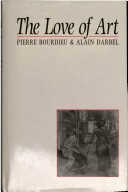Everyone can visit the art treasures held in the great museums of the world yet, in fact, art museums are visited by only a small segment of the population. What are the characteristics of those who display their love of art by strolling through the galleries of museums? What distinguishes them from the majority of people who are effectively excluded, or exclude themselves, from their doors? This classic study addresses such questions on the basis of a wide-ranging survey of museums and museum visitors in France, Greece, Spain, Italy, The Netherlands, and Poland. Central to the analysis of Pierre Bourdieu and his associates is the elaboration of the theory of culture as a form of capital. This work shows that art is of great value in society as cultural capital, yet to a great extent the appreciation of art is considered intensely personal, an innate taste, an appurtenance of aristocracy, something ineffable.
Bourdieu challenges this idea, asserting that it is merely one aspect of the ideological underpinnings of social inequality; further, that the power of the idea is such that it has come to pervade the beliefs of even culturally deprived groups, so that they accept and become accomplices in their exclusion and subordination. He reveals those mechanisms of society that together produce our conceptions of art, the artist, the public, and the creation of cultural value through semi-autonomous processes and institutions.
- ISBN10 0804715580
- ISBN13 9780804715584
- Publish Date 8 January 1991 (first published 29 November 1990)
- Publish Status Out of Print
- Out of Print 10 March 2007
- Publish Country US
- Imprint Stanford University Press
- Format Hardcover
- Pages 190
- Language English
